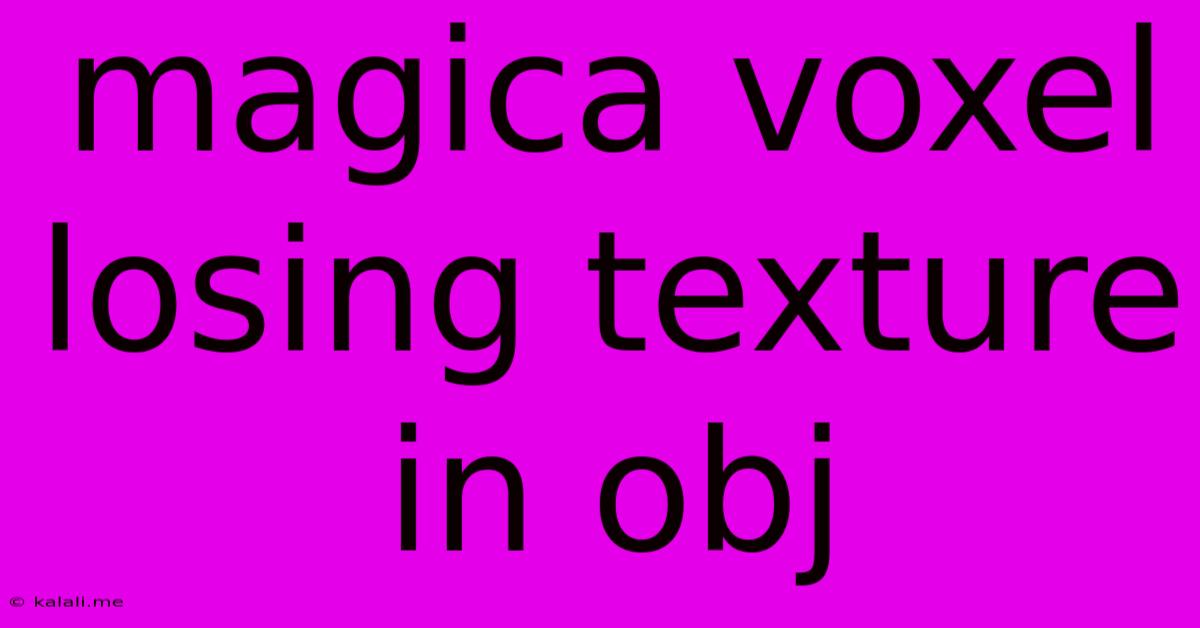Magica Voxel Losing Texture In Obj
Kalali
May 24, 2025 · 3 min read

Table of Contents
MagicaVoxel Losing Textures in OBJ Export: Troubleshooting and Solutions
Losing textures when exporting your MagicaVoxel creations as OBJ files is a frustrating but common problem. This guide will walk you through the potential causes and offer practical solutions to help you retain those beautiful textures in your 3D models. This issue often stems from incorrect export settings, file path issues, or compatibility problems with your chosen 3D software.
Understanding the Problem: MagicaVoxel excels at creating voxel art, and its intuitive interface makes texture application straightforward. However, the OBJ file format itself doesn't inherently handle textures in the same way MagicaVoxel manages them. The export process requires a careful understanding of how to correctly map the texture information onto the exported mesh. When textures disappear, it usually signifies a disconnect between the texture data within MagicaVoxel and how that data is interpreted by the importing application.
Common Causes of Missing Textures in OBJ Exports from MagicaVoxel
-
Incorrect Export Settings: This is the most frequent culprit. MagicaVoxel's export options don't always explicitly highlight texture handling. Overlooking crucial settings can result in the loss of texture information during the conversion.
-
File Path Issues: If your textures are located in a folder with spaces or special characters in the name, or if the relative path from your model to the texture is incorrect, the OBJ importer may fail to locate and apply the textures correctly. Absolute paths are generally more reliable.
-
Material File Issues (MTL): The OBJ format often relies on a companion Material Template Library (MTL) file to define material properties, including texture mapping. Any errors or inconsistencies in this MTL file can prevent textures from loading.
-
Incompatible Software: Different 3D modeling and animation software packages handle OBJ imports and texture mapping in their own unique ways. Some software may have limitations or quirks that affect the import process.
Troubleshooting Steps and Solutions
-
Double-Check Export Settings in MagicaVoxel: Carefully review all export options within MagicaVoxel. Ensure that texture export is enabled and that the correct texture is selected. Experiment with different export settings to isolate the problem.
-
Organize Your Files: Keep your texture files in the same directory as your MagicaVoxel project file. Using simple file names without spaces or special characters is highly recommended. Test exporting again with this organized file structure.
-
Verify the MTL File: After exporting, examine the accompanying MTL file. Make sure the texture file paths within the MTL file are correct and point to the actual texture files. Check for typos and ensure the paths are absolute paths (full path) or relative paths that are correct relative to the location of the .obj file.
-
Import into a Different 3D Software: Test the exported OBJ file in various 3D applications. If the textures display correctly in one application but not another, the issue lies with the importer of the problematic software, and you might need to adjust import settings there or consider a different program.
-
Re-export Using a Different Format (Optional): While OBJ is a common format, consider exporting to FBX or other formats that handle textures more reliably. These formats often embed texture information directly, reducing the risk of texture loss.
-
Check for Updates: Make sure both MagicaVoxel and your 3D software are updated to their latest versions. Bug fixes and improved compatibility can address underlying issues.
Preventing Future Texture Loss
- Use Simple File Names: Avoid spaces and special characters in your texture and model filenames.
- Absolute Paths are Best: Use absolute paths in your export process to avoid ambiguity.
- Back Up Your Work: Regularly back up your MagicaVoxel projects to prevent data loss.
- Test Regularly: Export your models frequently during the creation process to catch texture problems early on.
By following these troubleshooting steps and preventative measures, you can significantly reduce the chances of encountering texture loss when exporting your MagicaVoxel creations as OBJ files and ensure that your voxel art retains its vibrant and detailed appearance. Remember that persistence and methodical troubleshooting are key to resolving this common issue.
Latest Posts
Latest Posts
-
How To Get Rid Of Water In Minecraft
May 24, 2025
-
What Is A 3d Rectangle Called
May 24, 2025
-
Lyrics I Am The Highway Audioslave
May 24, 2025
-
How To Jump Start A Starter
May 24, 2025
-
How Do You Get Gasoline Smell Off Hands
May 24, 2025
Related Post
Thank you for visiting our website which covers about Magica Voxel Losing Texture In Obj . We hope the information provided has been useful to you. Feel free to contact us if you have any questions or need further assistance. See you next time and don't miss to bookmark.